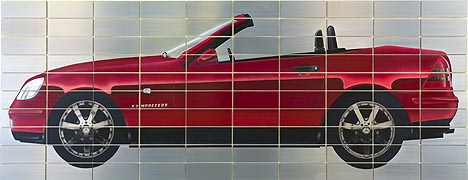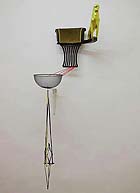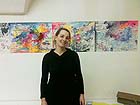
translated and summarized by: Liz Wollner-Grandville,
English summaries February 1 - 7
Albertina: Cars: Andy Warhol, Silvie Fleury, Robert Longo, Vincent Szarek
Boring PR-campaign
Expectations weren’t really high in the first place. What is the sense of an exhibit that devotes only four artistic positions to cars? Yet, with “Cars. Andy Warhol, Silvie Fleury, Robert Longo, Vincent Szarek” the Albertina offers us a theme-based exhibition of the worst kind. All of the works of this aberrant undertaking stem from the Daimler Art Collection – as if the Albertina itself does not own enough art to organize its own exhibitions.
The Bastei Hall, which has also hosted such magnificent projects as the Gunther Brus exhibit, now presents such an uncritical fetish. Andy Warhol’s “Cars”, once commissioned by the automobile concern, quickly tends to bore: the King of Pop obviously did not take his PR campaign for the car company very seriously – in view of how carelessly he created his work.
And the work by the other four artists – spread perfunctorily throughout the exhibit – make things even worse. Sylvie Fleury lets high-heeled sexy wenches stalk about amidst the cars, Robert Longo exaggerates the cars with icon-like pencil drawings and Vincent Szarek constructs smooth and glossy sculptures that remind of sleek cars.
But the real annoyance is not caused by the fact that there is absolutely no curatorial aspiration behind this show, but through the problematic relationship between a company collection and a public museum. The question that arises, is how large the funds are that the Albertina receives for such a marketing project – possibly an annex sponsored by Daimler or a few of Longo’s drawings? Or maybe even a permanent loan? Anyway, there would be quite a few opportunities to co-operate – and enough topics: the Fondazione Prada might be able to offer something for “The Handbag in the Context of 20th Century Art”, “The Airplane from Josef Beuys to Fischli/Weiss” could be a joint venture with Lufthansa, or “The Computer in Contemporary Art” could by set up by a not yet existent Apple Art Foundation.
By Nina Schedlmayer
Albertina
1010 Vienna, Albertinaplatz 1, until 16.05.10
www.albertina.at
Galerie Dana Charkasi – Plattform aktueller Kunst: Ben Washington – The Private Citizen
Serene splendour
How is it possible that time and again we are confronted with moments in which something prompts us to never forget what we saw? This question may allegorize a protestant and sober desire for intoxication. After all, intoxication can change time, similar to the moment that claims to be remembered forever.
There is drunkenness without a hangover, just like there are orgasms without sex - because the brain is a wonderful landscape, in which thousands of images appear - and one never knows when they appear. Whoever wants to view a new figure of beauty and mystery and the whispering of artefacts can - without any obligations and full of expectations - visit the Gallery Dana Charkasi - located in downtown Vienna, and admire the first solo exhibit in Austria of the London-based artist Ben Washington.
In the first room of the “The Private Citizen” the viewer is greeted by the work “King of the Road”, a floating installation created in 2010. Can the road have a king? Can two heavy wooden boards linked by an iron arch, constructed with lots of blue braces, balance a palm tree with golden leaves and thereby exert majestic power? And since kings are mainly good for fairy tales, and the road is mainly good for cars: should we really wish for such a strange mixture? “The Private Citizen” (2009) is positioned in the second room, and the privacy of a citizen seems free of governance. A citizen’s privacy includes many things that are nobody’s business outside of the city apartment intoxication, for example, is not punishable, as long as one is not caught driving.
The freedom of being confronted with a dignified brainteaser and the pleasure of its incomprehension in real life – is that what the intoxication of a private citizen could feel like? The individual parts of “The Private Citizen” are found and common, but torn out of their habit – an upholstered armrest, a golden-faceless animal figure, a sieve, into which blue colour was spilt, attached to the armrest with obscene orange-coloured, maybe shish kebab–sticks, and mounted on the wall with DIY-shelves. On the bottom of the sieve, and pointing sharply to the ground, there is a blue-blotted wooden pole construction, which is succinctly decorated in almost gothic arch squares. The object that is capable of all this is one whose proportions and happiness twitters like champagne bubbles on a powder light morning in May…. maybe.
Something like this is unusual, and Ben Washington’s work is unusually unusual. And there are other objects, and a vast number of letters and dialogues and thoughts will be used to describe them. Because the predator’s flickering of objects never ceases when objects are united beyond their traditional language, and their whispering begins to painlessly purr in the brain.
By Gesche Heumann
Galerie Dana Charkasi – Plattform aktueller Kunst
1010 Vienna, Fleischmarkt 11/2, until 27.02.10
www.dana-charkasi.com
quartier 21 MuseumsQuartier: kondition pluriel – abandoned
The viewer as a prop
“abandoned”, created by the artist group kondition pluriel, is the second exhibition presented at the showroom of the University for Applied Arts. Martin Kusch, artist and tutor at the university, and Marie-Claude Poulin staged this conceptual performative installation, which demands a great deal from the viewer.
On display are six terminals, each playing a different sequence. Three of them are positioned on an office desk, the others are distributed across the room. A camera is set up on the floor in front of one terminal, while a second one, mounted higher and rotatable, films the audience and the surrounding space. Additional props include a chair draped with clothes and crutches. The scene is staged in front of a large-format photo depicting a studio situation.
Starting point of the installation is a video showing a performance by Marie-Claude Poulin moving around on crutches. The adjacent terminals show generative depictions of the motion sequences - transmitted simultaneously with the help of sensors fixed to the dancer’s body: on the left, the movements of arms and head are shown in a curve-form, on the right, the same movements are visualized as deformations of a 3D cube. Another terminal repeats the performance in an analogue format - as a hybrid, and therefore somewhat blurred. The only audible noise is that of the appliances and the crutches as well as the constant tumbling of the dancer. The choreographed sequences are interrupted by recordings of the viewers taken from different angles, and remind of a surveillance system.
“abandoned” centres on the concepts of body, space, and perception. In images or likenesses, in a generative translation, digital revision and temporary absence of the individual elements an abundance of references, which as a complex network, enable the development of performative space. Within this space, the entire event is shown as a reciprocal reflection of the segments, quasi in a recurring loop. In this context, the human body is equally as relevant as one of the props. Through the parallel recording and playing of the viewer’s image in the installation, his presence is involved to such an extent that he finds himself in its midst. He/she is an integral part of the scenario, in a looping – generating a body, space, and perception.
By Margareta Sandhofer
quartier 21 MuseumsQuartier
1070 Vienna, Museumsplatz 1, until 21.03.10
quartier21.mqw.at
Ortner 2: Barbara Husar – KUNSTSTROM
Archaically modern
On the occasion of the release of Anna Barbara Husar’s art book “Kunsstrom” an exhibit of her small format paper paintings are simultaneously displayed at Ortner 2.
Husar is one of those artists, where it is essential to see the person behind the art first and it would not suffice to judge the work by itself. With her cheerful positive presence she is capable of lending the gallery and her work vitality – as well as presumably also in her own life. Similar - in a nearly diametrically opposed way – as it is not possible to imagine Christian Eisenberger as an art figure and human being independent from his oeuvre, one will constantly find references to the person Barbara Husar in her work. And whoever may not yet be acquainted with her paintings will easily find access through her unique trashy-poetical picture language, which are often created on objects such as cigarette boxes or fertilizer bags.
They are colourful paintings, completely covered with figures, stamps, and writing, which – on account of their size – fit perfectly into Ortner 2’s limited space and are only partially included in her art book “Kunststrom”. Stamped words such as herd, horizon or cradle, together with depictions of sheep and cows refer to her regular stays in the desert, but also to fundamental, quasi archaic structures that are far more than references to one of the archetypes of culture. Terms such as frequency, integral or high voltage current form the carefully considered counterpoint in the compositions and point to the fixation of this art in current, modern life.
The book, which is well-worth reading and browsing, is not what one would call low-priced, yet highly recommended to enter the lovingly quaint universe of this unusual artist.
By Wolfgang Pichler
Ortner 2
1010 Vienna, Sonnenfelsgasse 8, until 27.02.10
ortner2.at
Mehr Texte von translated and summarized by: Liz Wollner-Grandville


 Teilen
Teilen





